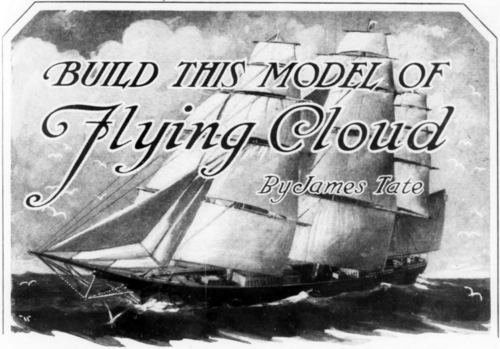
SHIP-MODEL PRIZES
Few hobbies enable the amateur to produce auch beautiful work with so few tools and such inexpensive material as ship-model building. To encourage such a worth-while and pleasant pastime, Popular Mechanics Magazine offers the following awards for the best models of the "Flying Cloud" made from plans published in this and subsequent issues:
- First, $100 cash and gold medal.
- Second, $50 cash and silver medal.
- Third, $25 cash and bronze medal.
- Five awards, $10 cash and bronze medal.
- Five awards. $5 cash and bronze medal.
Bronze medals also will be awarded for excellence in workmanship.
The contest is open to everyone, regardless of age or sex. The conditions are very simple, and full details will be aupplied to every reader addressing the Editor, Amateur Mechanics department, Popular Mechanics Magazine, 200 E. Ontario st., Chicago.
With the hull carved to shape, as in Fig. 19, the next step is the erection of the bulwarks. Cut a rabbet on each side of the quarterdeck, as shown in Fig. 18, and a similar one on each side of the after end of the foc's'le head. These rabbets should be about 11⁄4 in. long and a stout 1⁄16 in. deep; the bottom of the rabbets should be cut in line with the deck edge. Before going any further. it will be well to mark in the deck planking. Mark center lines down the decks, and, with the dividers, lay off the planks on either side of the lines, 1⁄8 in. wide. Rule pencil lines lightly along the decks, defining the planks. Cut a strip of wood 1 in. wide and 1⁄16 in. thick, make one edge straight and use this as a straightedge when ruling and scoring the lines: the flexible wood will lie closer to the deck than a regular straightedge. Now take a putty knife or similar tool, and score in the planking lines as shown in Fig. 25. A scriber will do for this job, but the point must be slightly rounded, else it has a tendency to follow the grain of the wood, and produce crooked "planks." The putty knife, used as shown, is an excellent tool for the job. After the deck lines have been scored in, stain the decks slightly with light-oak wood dye, made very light with turpentine. The object here is to get a deck that will look weatherworn yet "clean."
The deck should be very slightly brownish-yellow. Don't leave the decks white; ships' decks were
